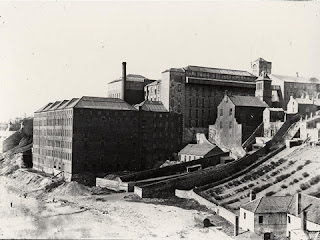Arches and Rectangles
I was intrigued yesterday when photographing the canvas factory. The building seemed to have two very distinct parts. One a single storey building with lovely stone arched window recesses and fascinating roof supports and the other an elegant three storey premises with rectangular windows and an impressive sweeping profile. For all intents and purposes there appeared to be two separate buildings. My puzzle was soon to be solved when last night I picked up Nairns of Kirkcaldy. Browsing through its pages I spotted a section entitled - St Mary's Canvas Factory. Apparently what I had suspected was correct and there were indeed two buildings. The single storey premises constructed probably around the early 1860s (no specific date is given) marked a period of manufacturing diversification for the Narins. The small factory at the foot of the Path produced a varied range of products including table baize, black Japan cloths, hessians, marbled linen, waterproof carriage-roofing, stair-cloths, bath and coal scuttle mats, and gig and carriage oil-cloths.
By the late 1860s Michael Barker Nairn started to build alongside this factory to create the St Mary's Canvas Factory. This building heralded a new industrial era for the Nairns with the birth of the steam power loom capable of weaving canvas eight yards wide.
Fascinated by some of the products produced by the smaller of the two factories I decided to undertake some research. I had always thought table baize referred to the green felt covers that adorned the snooker and billiard tables of gentlemens clubs and stately homes. But no, in the book there was reference to table baize having a backing of cotton and being printed in three different patterns. Entering baize into Google I discovered:
Baize - A coarse, napped, felt-like, woollen or cotton material that goes back at least to the 1500s and used as a protective cover for carpets, tables and bookcases in the 18th and 19th centuries.
The only image I have been able to find for a table baize, that isn't green and snooker/billiard/card game related, is for an 1868 block printed baize - see image held by the Bridgeman.
By the late 1860s Michael Barker Nairn started to build alongside this factory to create the St Mary's Canvas Factory. This building heralded a new industrial era for the Nairns with the birth of the steam power loom capable of weaving canvas eight yards wide.
Fascinated by some of the products produced by the smaller of the two factories I decided to undertake some research. I had always thought table baize referred to the green felt covers that adorned the snooker and billiard tables of gentlemens clubs and stately homes. But no, in the book there was reference to table baize having a backing of cotton and being printed in three different patterns. Entering baize into Google I discovered:
Baize - A coarse, napped, felt-like, woollen or cotton material that goes back at least to the 1500s and used as a protective cover for carpets, tables and bookcases in the 18th and 19th centuries.
The only image I have been able to find for a table baize, that isn't green and snooker/billiard/card game related, is for an 1868 block printed baize - see image held by the Bridgeman.


Comments